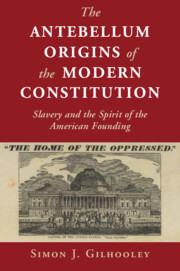Book contents
- The Antebellum Origins of the Modern Constitution
- Cambridge Studies on the American Constitution
- The Antebellum Origins of the Modern Constitution
- Copyright page
- Dedication
- Epigraph
- Contents
- Acknowledgments
- Introduction
- 1 The Constitutional Imaginaries of the Missouri Crisis
- 2 The Declaration of Independence and Black Citizenship in the 1820s
- 3 Abolitionism and the Constitution in the 1830s
- 4 The Slaveholding South and the Constitutionalization of Slavery
- 5 Theories of the Federal Compact in the 1830s
- 6 Slavery, the District of Columbia, and the Constitution
- 7 The Congressional Crisis of 1836
- 8 The Compact and the Election of 1836
- 9 The Afterlife of the Compact of 1836
- Conclusion
- Bibliography
- Index
3 - Abolitionism and the Constitution in the 1830s
Published online by Cambridge University Press: 16 October 2020
- The Antebellum Origins of the Modern Constitution
- Cambridge Studies on the American Constitution
- The Antebellum Origins of the Modern Constitution
- Copyright page
- Dedication
- Epigraph
- Contents
- Acknowledgments
- Introduction
- 1 The Constitutional Imaginaries of the Missouri Crisis
- 2 The Declaration of Independence and Black Citizenship in the 1820s
- 3 Abolitionism and the Constitution in the 1830s
- 4 The Slaveholding South and the Constitutionalization of Slavery
- 5 Theories of the Federal Compact in the 1830s
- 6 Slavery, the District of Columbia, and the Constitution
- 7 The Congressional Crisis of 1836
- 8 The Compact and the Election of 1836
- 9 The Afterlife of the Compact of 1836
- Conclusion
- Bibliography
- Index
Summary
This chapter explores the ways in which the interracial immediatist abolition movement of the early 1830s fashioned a conception of abolition as the fulfillment of commitments made at the time of the Revolution but which subsequent actions had left unmet. Casting themselves as acting in parallel to the founding fathers and expressing concern for the possibility of transmitting an unfulfilled revolutionary settlement to posterity, abolitionists sought to navigate their relationship with the nation’s founding documents. Attempting to systematize this relationship, some came to argue that the Constitution ought to be interpreted in accordance with the Declaration of Independence. Others would go further and argue that the Declaration was more fundamental than the U.S. Constitution itself. Just as earlier arguments had cultivated a sense of American national identity tied to the principle of equality, these variations furthered the association of the claim that “all men are created equal” with the American sense of self and contributed to the formation of a national identity with significant ideological content.
Keywords
- Type
- Chapter
- Information
- The Antebellum Origins of the Modern ConstitutionSlavery and the Spirit of the American Founding, pp. 63 - 86Publisher: Cambridge University PressPrint publication year: 2020

